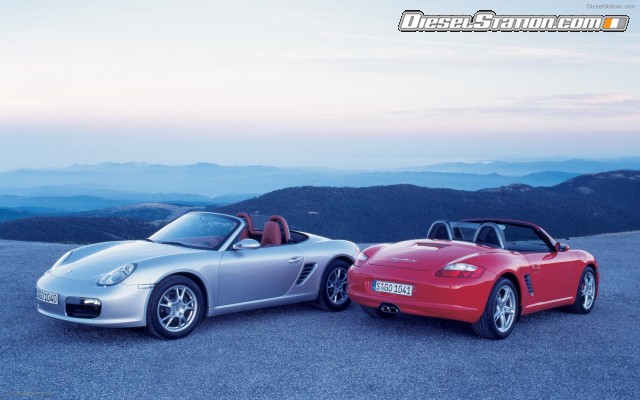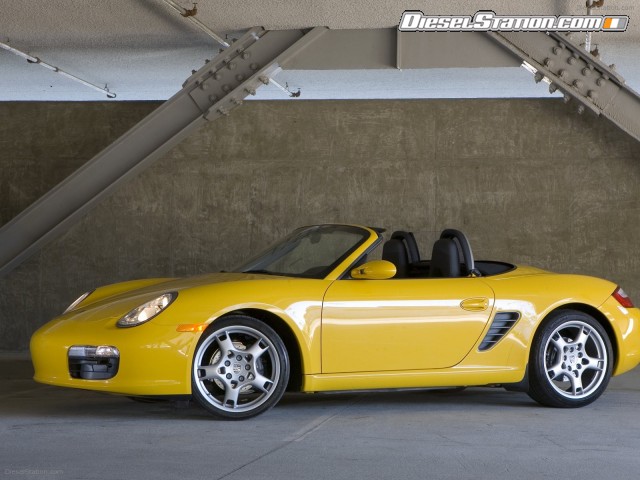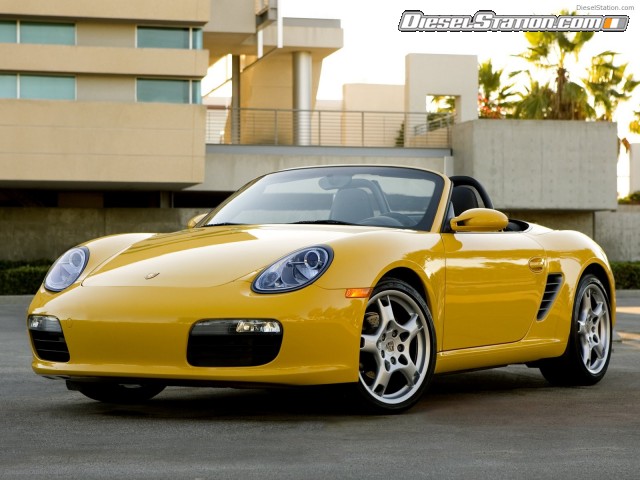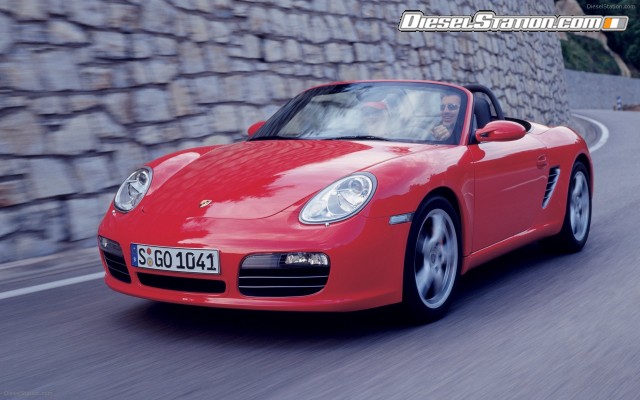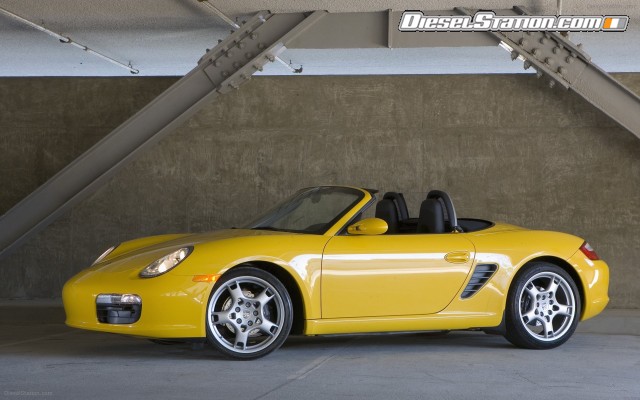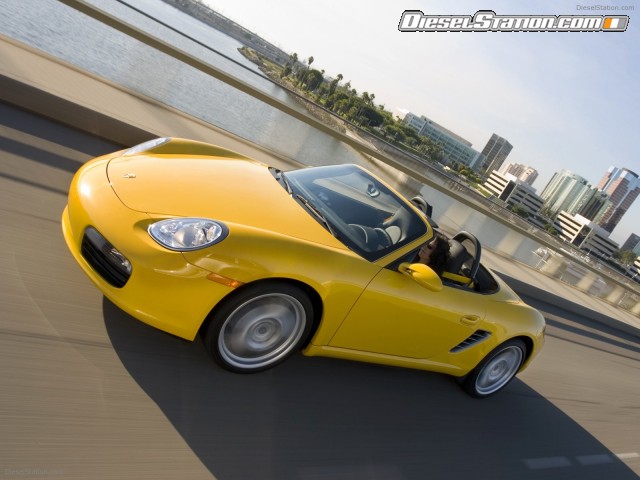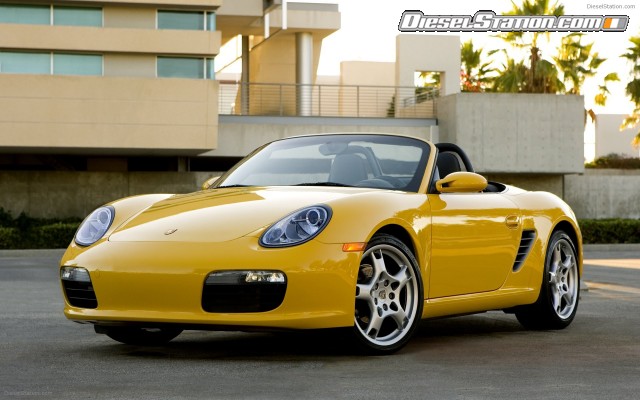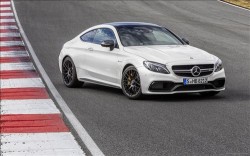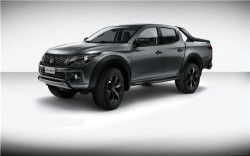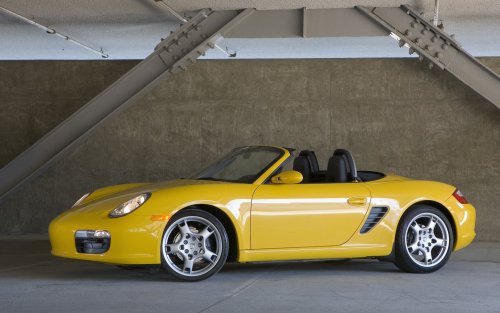The potent Boxster S goes into 2008 with a 3.4-liter flat six-cylinder that boasts the same technology as the smaller engine. The result is a Boxster S with 295 horsepower and 251 lb.-ft. of torque. The potent powerplant hurtles the Boxster S from zero to 60 mph in only 5.1 seconds. The Boxster S can be equipped with either a six-speed manual or five-speed Tiptronic S transmission.
Continue reading for more details.
As the spiritual descendants of the legendary 356 Speedster and 550 Spyder, the Porsche
Boxster and Boxster S carry the company's torch of affordable, open-top driving excitement.
After receiving power boosts last year, the mid-engine roadsters go into 2008 with minor
refinements.
What's new
As with other Porsche models, the Boxster and Boxster S can be equipped with new optional
sports folding bucket seats. These are lightweight, highly contoured seats with adjustable
backrests.
A new exterior color, Macadamia Metallic, has been added to the palette and Carrera Red is now
offered as an interior natural leather option.
Finally, the recommended oil-change interval is now 12,000 miles/one year and spark plugs
should be replaced every 36,000 miles/four years.
VarioCam Plus equipped six-cylinder engines
Last year, the Boxster and Boxster S each received an adrenalin injection in the form of revised, more powerful engines. The Boxster continues in '08 with a 245-horsepower 2.7-liter, horizontally opposed six-cylinder with Porsche’s VarioCam Plus system. This valve control technology adjusts both intake valve lift and timing for better performance and fuel efficiency. The engine develops 201 lb.-ft. of torque and can be mated to either a five- or six-speed manual gearbox or a five-speed Tiptronic S. The Boxster accelerates to 60 mph in 5.8 seconds.
The potent Boxster S goes into 2008 with a 3.4-liter flat six-cylinder that boasts the same
technology as the smaller engine. The result is a Boxster S with 295 horsepower and 251 lb.-ft. of
torque. The potent powerplant hurtles the Boxster S from zero to 60 mph in only 5.1 seconds.
The Boxster S can be equipped with either a six-speed manual or five-speed Tiptronic S
transmission.
Cleaner and more fuel frugal
Besides delivering more power than in their original iterations, the Boxster is now certified as an
Ultra Low Emissions Vehicle (ULEV), while the Boxster S earns a LEV-II (Low Emissions Vehicles,
category two) rating. And with EPA fuel economy ratings of 20 mpg in the city and 29 mpg
highway for the five-speed Boxster, and 18 mpg city and 26 mpg highway for the Boxster S with
manual gearbox, both cars deliver Porsche performance without the stigma of a gas guzzler
penalty.
Efficient mid-engine roadster configuration
As proper roadsters, the Boxster and Boxster S have been designed to accommodate two people
and a modicum of cargo in a small, agile, open-top, and powerful sports car. As part of the
Porsche family, the Boxster and Boxster S have their six-cylinder horizontally opposed engines
mounted behind the passenger cabin. In fact, the chassis is a true mid-engine design for the
optimum balance needed for superb road holding and response.
Open-top occupant protection
All Boxsters are equipped with three-point inertia-reel seat belts with belt-latch tensioners and beltforce
limiters as well as six airbags. In addition to two-stage frontal airbags, the Boxster and
Boxster S feature the Porsche Side Impact Protection (POSIP) system with torso-protecting thorax
side-impact airbags mounted in the outer edges of the seatbacks and special head-protecting sideimpact
airbags which deploy from the doors' windowsills.
The frontal airbags benefit from the use of an organic-based propellant which reduces their
needed storage space and their weight, while also easing their recyclability. To protect small
children, the passenger seat sensors automatically defeat the passenger front airbags if the
sensors detect a light-weight occupant.
Stability is standard
Both the 2008 Boxster and Boxster S are equipped with enhanced Porsche Stability Management
(PSM) as standard equipment.
The Boxster and Boxster S are equipped with four-wheel disc antilock brakes. Both cars have
cross-drilled rotors and four-piston monobloc aluminum calipers at all four wheels. Those drivers
of the Boxster S who desire even greater braking power than standard may opt for Porsche
Ceramic Composite Brakes (PCCB).
No spare needed
To save 22 pounds (10 kg) and increase room for cargo, both the Boxster and Boxster S are
equipped with an electric air compressor and emergency tire sealant. There are no spare tire, jack
or tire-changing tools.
Porsche’s engineers know that correct inflation pressures are not just critical for safety, but also
mandatory for exacting the full measure of a car's dynamics. Therefore both the Boxster and
Boxster S come equipped with the Porsche Tire Pressure Monitoring System (TPMS) as standard
equipment.
Convenient cargo carrying, front and rear
The mid-engine design allows for a versatile trunk aft the engine. In 2007, Porsche's engineers
repositioned the service tray, giving that trunk a more symmetrical shape. This modification
smoothed the right trunk wall. Though trunk capacity is essentially unchanged at 4.6 cu.-ft. (130
liters), the space is more usable. The rear trunk is complemented by the front luggage
compartment which has a 5.3 cu.-ft. (150 liter) capacity.
Automatic lightweight folding top
The soft top of the Boxster and Boxster S is power operated at the touch of a button. And since
Porsche engineers understand full well that conditions can change suddenly, the top can be
operated even when the car is moving at speeds up to approximately 30 mph.
More performance available
Enhanced engine, transmission and suspension response are available in both Boxster and
Boxster S with the optional Sport Chrono Package (Plus). This feature allows more aggressive
control maps for the engine speed limiter, Porsche Stability Management (PSM), and for the
optional Porsche Active Suspension Management (PASM), and Tiptronic S. The feature is activated
by pressing a button on the center console. The package also includes a separate stopwatch
gauge on top of the instrument panel.
Porsche Active Suspension Management is optional on both Boxster and Boxster S and automatically adjusts to the driver's style. PASM offers the driver a choice of two basic shock settings, Normal and Sport. At the core of PASM are continuously adjustable shocks, a front and rear accelerometer and a dedicated electronic control unit.
Plethora of options
At the head of the list is the enhanced Porsche Communication Management (PCM). This boasts a
DVD-based navigation system. The navigation system features 23 stages of map magnification
from a minimum resolution of 55 yards (50 meters). Information is displayed on a 5.8-inch color
monitor.
Available in conjunction with PCM is a multifunction steering wheel with redundant controls for audio, navigation and telephone functions. The standard four-speaker audio system has been refined, with the Porsche CDR-24 CD radio having a larger control surface illuminated by white LEDs. There are two audio options. A sevenspeaker, 180-watt Porsche Sound Package Plus with an external amplifier is standard on the Boxster S and available on the Boxster. For those desiring even more audio performance, there is also an optional 325-watt Bose® Surround System with a seven-channel digital amplifier and eleven speakers available on the Boxster and Boxster S.
Other options include Bi-Xenon® headlamps and Park Assist that uses ultrasound to measure the
distance from the rear bumper to the nearest detectable obstacle and warns the driver as needed.




